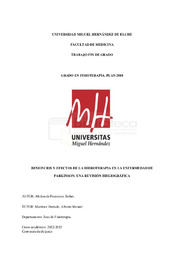Por favor, use este identificador para citar o enlazar este ítem:
https://hdl.handle.net/11000/30245Registro completo de metadatos
| Campo DC | Valor | Lengua/Idioma |
|---|---|---|
| dc.contributor.advisor | Martínez Hurtado, Alberto Manuel | - |
| dc.contributor.author | Molina de Francisco, Esther | - |
| dc.contributor.other | Departamentos de la UMH::Patología y Cirugía | es_ES |
| dc.date.accessioned | 2023-11-22T09:02:59Z | - |
| dc.date.available | 2023-11-22T09:02:59Z | - |
| dc.date.created | 2023-06-10 | - |
| dc.identifier.uri | https://hdl.handle.net/11000/30245 | - |
| dc.description.abstract | Introducción: La prevalencia de la Enfermedad de Parkinson (EP) aumenta conforme la población crece y envejece. Debido a esto es necesario buscar tratamientos que mejoren la calidad de vida de estas personas que sean seguros, eficaces y sin efectos secundarios. La terapia acuática (TA) o hidroterapia se ha evidenciado como un tratamiento de fisioterapia ideal para este tipo de enfermedades crónicas. Objetivos: Revisar a través de la literatura científica los beneficios y efectos de la TA en personas con EP. Material y métodos: Se realizó una búsqueda en diferentes bases de datos (PubMed, PEDro y Cochrane) con las palabras ``hydrotherapy´´ y ``Parkinson Disease´´ unidas por el operador boleano AND. Se aplicaron ciertos criterios de inclusión y exclusión y se obtuvo un total de 14 artículos seleccionados tras filtrar los 91 obtenidos inicialmente. Resultados: De los 14 artículos seleccionados 11 de ellos tuvieron beneficios en alguna variable analizada, resultando muy positiva la TA frente a otros tratamientos convencionales en la EP. A todos los artículos se les pasó la escala de PEDro para evaluar la calidad de éstos. Conclusión: Se encontró evidencia sobre los múltiples beneficios que se obtienen de la TA (equilibrio, movilidad y calidad de vida, principalmente), siempre y cuando se realice con un profesional y un ambiente seguro para los pacientes. Además, la hidroterapia puede ser una forma segura y efectiva de ejercicio para este tipo de paciente que tiene dificultad para realizar actividades físicas en tierra firme. | es_ES |
| dc.description.abstract | Introduction: The prevalence of Parkinson's Disease (PD) increases as the population grows and ages. Due to this, it is necessary to look for safe, effective and side- effect free treatments that improve the quality of life of these people. Aquatic therapy or hydrotherapy has been shown to be an ideal physiotherapy treatment for this type of chronic disease. Objectives: To Review through scientific literature the benefits or effects of aquatic therapy in people with PD. Material and methods: A search was carried throughout different databases (PubMed, PEDro and Cochrane) using the words ``hydrotherapy'' and ``Parkinson disease'' joined by the Boolean AND operator. Certain inclusion and exclusion criteria were applied and a total of 14 selected articles were obtained after filtering the 91 initially obtained from the sum of the 3 databases. Results: Of the 14 articles selected, 11 of them had benefits in any variable analyzed, with aquatic therapy being very positive compared to other conventional treatments in PD. the PEDro scale was applied to all articles to asses their quality. Conclusion: Evidence was found on the multiple benefits obtained from AT (mainly balance, mobility and quality of life), as long as it is performed with a professional and in a safe environment for patients with Parkinson's disease. Additionally, hydrotherapy may be a safe and effective form of exercise for people with Parkinson's who have difficulty performing physical activities on dry land | es_ES |
| dc.format | application/pdf | es_ES |
| dc.format.extent | 29 | es_ES |
| dc.language.iso | spa | es_ES |
| dc.publisher | Universidad Miguel Hernández de Elche | es_ES |
| dc.rights | info:eu-repo/semantics/openAccess | es_ES |
| dc.rights.uri | http://creativecommons.org/licenses/by-nc-nd/4.0/ | * |
| dc.subject | hidroterapia | es_ES |
| dc.subject | enfermedad de Parkinson | es_ES |
| dc.subject | terapia acuática | es_ES |
| dc.subject.other | CDU::6 - Ciencias aplicadas | es_ES |
| dc.title | Beneficios y efectos de la hidroterapia en la enfermedad de Parkinson: un revisión bibliográfica | es_ES |
| dc.type | info:eu-repo/semantics/bachelorThesis | es_ES |

Ver/Abrir:
TFG ESTHERMOLINA.pdf
717,8 kB
Adobe PDF
Compartir:
 La licencia se describe como: Atribución-NonComercial-NoDerivada 4.0 Internacional.
La licencia se describe como: Atribución-NonComercial-NoDerivada 4.0 Internacional.
.png)